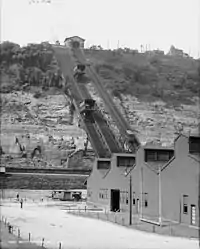Monongahela Incline
The Monongahela Incline is a funicular located near the Smithfield Street Bridge in Pittsburgh, Pennsylvania. Designed and built by Prussian-born engineer John Endres in 1870, it is the oldest continuously operating funicular in the United States.
| Monongahela Incline | |
|---|---|
 | |
 Lower station of the Monongahela Incline | |
| Overview | |
| Owner | Pittsburgh Regional Transit |
| Locale | Pittsburgh, Pennsylvania, U.S. |
| Termini |
|
| Stations | 2 |
| Service | |
| Type | Funicular |
| History | |
| Opened | May 28, 1870 |
| Technical | |
| Line length | 635 feet (194 m) |
| Track gauge | 5 ft (1,524 mm) |
| Electrification | 1935 |
| Operating speed | 6 mph (9.7 km/h) |
Monongahela Incline | |
   | |
| Location | Grandview Avenue at Wyoming Avenue, Pittsburgh, Pennsylvania |
| Coordinates | 40°25′55″N 80°0′20″W |
| Area | 1 acre (0.40 ha) |
| Built | 1869 |
| Architect | John Endres and Caroline Endres |
| Architectural style | Late 19th and 20th Century Revivals, Second Renaissance Revival |
| NRHP reference No. | 74001742[1] |
| Significant dates | |
| Added to NRHP | June 25, 1974 |
| Designated CPHS | March 15, 1974[2] |
| Designated PHLF | 1970[3] |
It is one of two surviving inclines in Pittsburgh (the other is the nearby Duquesne Incline) from the original 17 passenger-carrying inclines built there starting in the late 19th century. Its lower station is across the street from what is now the Station Square shopping complex. It is easily accessible from the light rail system at the Station Square station.
It was listed on the National Register of Historic Places in 1974. In 1977 both inclines were designated as Historic Mechanical Engineering Landmarks by the American Society of Mechanical Engineers (ASME).[4]
History

Pittsburgh's expanding industrial base in 1860 created a huge demand for labor, attracting mainly German immigrants to the region. This created a serious housing shortage as industry occupied most of the flat lands adjacent to the South Side of the Monongahela River, leaving only the steep, surrounding hillsides of Mt. Washington, or "Coal Hill", for housing. However, travel between the "hill" and other areas was hindered by the steep terrain and a lack of public transport or good roads.
The predominantly German immigrants who settled on Mt. Washington, remembering the seilbahns (cable cars) of their former country, proposed construction of inclines along the face of Coal Hill.
Prussian-born engineer John Endres of Cincinnati, Ohio was commissioned to design the Monongahela Incline, which opened on May 28, 1870, as the first for passenger use. On the first day, some 944 fares were collected. But the second day, 4,174 people rode the incline and it became a success.[5] He was assisted by his American-born daughter, Caroline Endres, who was educated in Europe and became one of the first women engineers in this country.[6][7][8]
Earlier inclines were used to transport coal in the Pittsburgh area, including the Kirk Lewis incline on Mt. Washington, and the Ormsby mine gravity plane in nearby Birmingham, which was later annexed to the city of Pittsburgh.
The Monongahela Incline was listed on the National Register of Historic Places in 1974. Both it and the Duquesne Incline were recognized in 1977 as Historic Mechanical Engineering Landmarks by the American Society of Mechanical Engineers (ASME).[5] That year the two inclines served a total of more than one million commuters and tourists annually.[5]
In the 21st century, the Monongahela Incline is operated by Pittsburgh Regional Transit, which operates the rest of Allegheny County's transit system. Transfers can be made between the incline, light rail, and buses free of additional charge.[9] It serves both commuters and visitors, and is a popular tourist attraction.
On February 2, 2019, flooding caused by a broken city water main forced the incline to close.[10] The extensive repairs took time to complete, but the incline reopened 13 weeks later on May 10, 2019.[11]
Statistics
- Length: 635 feet (194 m)
- Elevation: 369.39 feet (112.59 m)
- Grade: 35 degrees, 35 minutes
- Gauge: 5 ft (1,524 mm) broad gauge
- Speed: 6 mph (9.7 km/h)
- Passenger Capacity: 23 per car
- Opened: May 28, 1870
- Renovated: 1882 (with steel structure)
- Original steam power replaced with electricity: 1935
- Renovated: 1982–83 new track structure, cars and stations
- Renovated: 1994 upper, lower stations, restored cars, replaced electric motors and controls[4]
- Renovated: 2022–23 upper, lower stations, mechanical controls, electrical system, exterior track lighting[12]
Gallery
 Interior of the lower station
Interior of the lower station Ascending
Ascending Descending view
Descending view P. & L.E. Ry. Pittsburgh and Lake Erie Railroad station on far riverbank, and two inclines: Monongahela Freight Incline (L) and Monongahela Incline (R), on Mt. Washington, c.1905
P. & L.E. Ry. Pittsburgh and Lake Erie Railroad station on far riverbank, and two inclines: Monongahela Freight Incline (L) and Monongahela Incline (R), on Mt. Washington, c.1905
See also
References
- "National Register Information System – (#74001742)". National Register of Historic Places. National Park Service. July 9, 2010.
- "Local Historic Designations". Pittsburgh: Pittsburgh History & Landmarks Foundation. Retrieved 2011-08-09.
- "Historic Landmark Plaques 1968-2009" (PDF). Pittsburgh History and Landmarks Foundation. 2010. Retrieved 2011-08-05.
- "Monongahela and Duquesne Inclines" (PDF). ASME. 11 May 1977.
- Leherr, Dave (7 May 1977). "Inclines Rise to National Landmarks". Pittsburgh Post-Gazette. p. 9.
- "Monongahela and Duquesne Inclines" (PDF). Archived from the original (PDF) on 2009-08-16. Retrieved 2009-05-21.
- "Legendary Ladies" (PDF). Pennsylvania Commission for Women. Archived from the original (PDF) on 24 May 2011. Retrieved 21 March 2006.
- Caroline Enders and John Enders (biographical sketch with photos), in The Pittsburgh Press, December 4, 1955, p. 167. Pittsburgh, Pennsylvania: The Pittsburgh Press (available via Newspapers.com; subscription required).
- "PortAuthority.org - Inclines". www.portauthority.org. Retrieved 2019-10-07.
- "Port Authority making progress to repair flooded Monongahela Incline station". Retrieved April 16, 2019.
- "Monongahela Incline Closed Briefly Friday Morning". 10 May 2019. Retrieved May 21, 2019.
- "StackPath". www.masstransitmag.com. 6 March 2023. Retrieved 2023-03-06.
External links
- Historic American Engineering Record (HAER) No. PA-226, "Monongahela Incline Plane", 28 photos, 36 data pages, 7 photo caption pages
- Lower Station from Google Maps Street View
- Upper Station from Google Maps Street View
- Pittsburgh Transit History Site
.svg.png.webp)

